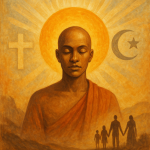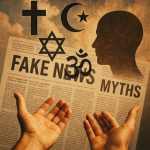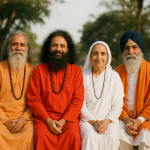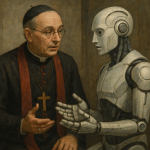Religion in a Post-Truth World: Fake News, Mythmaking & Faith Narratives
We live in an era often described as post-truth — a time when emotions outweigh evidence, and beliefs spread faster than facts. In this landscape, religion finds itself both a participant and a victim. While faith has always been about belief beyond proof, the digital age has blurred the line between sacred truth and social manipulation. Fake news, viral myths, and distorted narratives now circulate in the name of religion, shaping identities, fueling divisions, and sometimes even rewriting history. Yet amid this chaos, faith also holds the power to restore integrity and compassion to public discourse — if its moral voice is used wisely.
The Rise of the Post-Truth Culture
The term post-truth does not mean truth has disappeared; it means truth has lost its authority. Social media platforms have replaced traditional gatekeepers of information — priests, teachers, journalists — with algorithms that reward outrage over accuracy. What trends becomes what’s true. In such an environment, religion — already dealing with symbolic and emotional ideas — is easily manipulated.
In India and across the world, digital platforms are flooded with viral videos, edited images, and fabricated stories linking faith to politics, identity, or fear. A rumor about temple desecration or a doctored quote from a religious leader can spark anger within minutes. This weaponization of belief turns sacred symbols into social media ammunition.
Ironically, the same tools that once helped spread spiritual teachings — from online satsangs to digital scriptures — are now also breeding misinformation cloaked in religiosity. The post-truth ecosystem thrives on emotional triggers, and religion, being deeply emotional, becomes an easy target.
Mythmaking in the Digital Age
Mythmaking has always been part of religion. Ancient stories of gods, saints, and miracles were never meant as fake news but as moral metaphors — guiding humans toward virtue. However, the modern mutation of myth is different. Today’s digital myths are often stripped of symbolic meaning and weaponized for ideological gain.
When religious tales are used to justify hatred or superiority, they cease to be myths and become propaganda. Online networks amplify selective readings of scriptures to promote exclusion or nationalism. Fake quotes attributed to gurus or deities circulate widely, shaping public opinion without scrutiny.
Yet, mythmaking need not always be negative. Some spiritual influencers and educators are reclaiming myth as a tool for truth — retelling the Ramayana or Bible stories in ways that highlight compassion, equality, and courage. The challenge is not to erase myth but to interpret it responsibly, preserving its moral depth while rejecting manipulation.
Faith Narratives and Information Wars
Religious narratives are powerful because they connect with human emotion — the longing for meaning, justice, and belonging. In a fragmented digital world, people cling to faith-based identities as anchors of certainty. However, this very need makes them vulnerable to disinformation campaigns that exploit religious pride or fear.
Political actors often understand this better than spiritual ones. They use digital narratives that merge religion with nationalism, turning devotion into a form of propaganda. For instance, posts glorifying a particular community while demonizing another can spread under the guise of cultural pride. These micro-myths shape collective memory and can polarize societies.
Religious leaders face a new responsibility here: to become fact-checkers of faith. By clarifying teachings, discouraging rumor circulation, and promoting interfaith dialogue, they can counteract the emotional manipulation that thrives in the post-truth era. Silence, in such times, is complicity.
The Role of Technology and Algorithms
Technology itself is neutral — but algorithms are not. They are designed to maximize engagement, not enlightenment. Controversial or emotional religious content gets more clicks, keeping users online longer. This creates a feedback loop where sensationalism overpowers sincerity.
Faith organizations can respond by using the same platforms ethically — producing accurate, compassionate, and well-researched spiritual content. Many temples, gurdwaras, and churches have already launched verified digital channels, offering live sermons, community updates, and fact-based teachings. The digital battlefield can thus become a space of healing rather than hostility.
Artificial Intelligence also adds complexity. Deepfakes and synthetic media can mimic religious figures or fabricate visions, confusing believers. The idea of “seeing is believing” no longer holds true. Spiritual literacy — the ability to distinguish faith from falsehood — is now as essential as digital literacy.
Restoring Sacred Truth in a Post-Truth World
Religion, at its core, is not just about belief but about seeking truth. All great traditions — Hinduism’s Satya, Christianity’s “Truth shall set you free,” Islam’s Haqq (Truth), Buddhism’s insight into reality — place truth at the center of spiritual growth. The challenge today is to reassert that truth in the moral and ethical sense, not just the factual.
Faith leaders, educators, and followers must promote critical thinking as a form of devotion. Asking questions does not weaken faith; it purifies it. Interfaith education in schools and communities can also build resilience against misinformation by fostering empathy and understanding.
Moreover, religious institutions must embrace transparency. Whether in finances, teachings, or social positions, openness builds trust — the best antidote to rumor and deceit. When religion models honesty, it reclaims its moral authority in a world drowning in half-truths. In the post-truth world, religion stands at a crossroads. It can either become a victim of misinformation or a guardian of moral clarity. Fake news may distort facts, but genuine faith seeks deeper truth — the kind that unites rather than divides.
The future of faith communication depends on integrity. As algorithms evolve and myths multiply, the responsibility lies with believers, not machines, to ensure that the sacred is not sacrificed to the sensational. Religion must remind humanity that truth is not what trends online — it is what transforms the heart.
~Religion World Bureau









